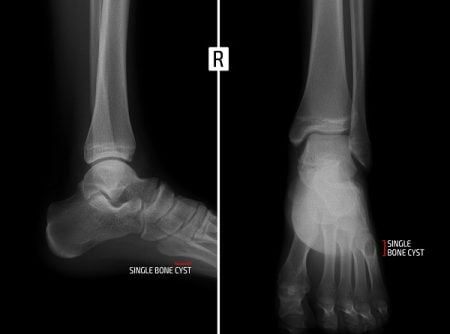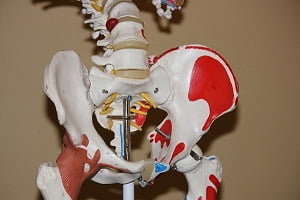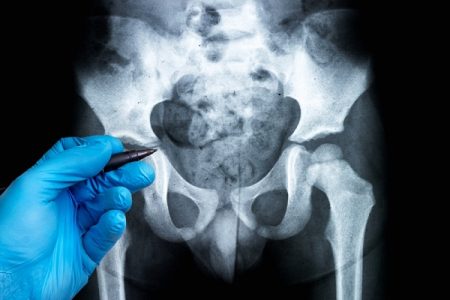What is a bone cyst?
A bone cyst is a hole filled with fluid that develops within a bone. They can develop at any age, but most often bone cysts affect children and young adults.

Types of bone cysts
There are mainly two types of bone cysts as follows:
- Unicameral bone cysts
- Aneurysmal bone cyst
Unicameral bone cysts
Unicameral bone cysts are the most common of all bone cysts. They can develop anywhere in the body. However, most cases of these cysts occur either in the upper arm or thigh.
These cysts develop mostly in younger children between the ages of 5 and 15 years. Boys are almost twice as likely to develop unicameral bone cysts as girls.
Aneurysmal bone cysts
Aneurysmal bone cysts are rare type of cysts affecting about one in every million people in a given year. In these cysts, the bone develops a pocket of blood. These cysts can also develop anywhere in the body, but most often affect they affect the legs, upper arms, spine, and pelvis.
Most cases occur in children and young people between 10 and 20 years of age. Scientists believe that aneurysmal bone cysts are slightly more common in females than in males.
Bone cyst symptoms
Bone cysts do not usually show any symptoms. They are discovered when you fracture (break) your bone, or when you have an X-ray of the bone.
Symptoms of unicameral bone cyst
Most unicameral bone cysts do not cause any symptoms unless the bone has been excessively weakened by the cyst so as to cause a fracture or severe pain. A child may experience painful symptoms in such situations particularly when exerting a force or placing a weight on the bone.
If the cyst causes the bone to fracture, your child may experience additional symptoms, such as:
- pain
- swelling
- angulation: the affected body part is bent at an unusual angle
- inability to move
- pain when you put weight on the injured limb
- bruising or discoloured skin around the bone or joint
Symptoms of aneurysmal bone cyst
Common symptoms of an aneurysmal bone cyst are:
- reduced range of movement
- weakness in the affected limb or body part
- stiffness in the affected body part
- a persistent dull pain that gets worse over time
- swelling
- a lump in the bone that can sometimes be noticed
- the affected part looks deformed
- the skin in the affected area may be warm to the touch
- you will experience abnormal working of the nervous system if the cyst develops in spine. This can cause symptoms such as muscle weakness, a sharp pain in the legs or arms, headaches, numbness or a tingling sensation in the arms and legs, inability to move body’s muscles.
Causes of bone cysts
The cause or causes of both unicameral and aneurysmal bone cysts are not exactly clearScientists have provided several theories to suggest the possible cause.
- One of the theories suggests that unicameral bone cysts are developed due to a build-up of fluid that results in high pressure and blockage.
- There may be genetic mutations that can make a person more susceptible to develop a bone cyst.
- Blood deposits inside an aneurysmal bone cyst. This means that an underlying abnormality with the blood vessels inside an affected bone causes these types of cysts. But, it is not clear exactly what type of abnormality causes them.
- Another theory is that non-cancerous growths (benign tumours) inside the bone may disrupt the blood supply causing the formation of an aneurysmal bone cyst.
- It is also believed that a previous injury in the bone that may damage the blood vessels may lead to a build-up of blood inside the bone.
Diagnosis of bone cysts
Bone cysts are usually diagnosed by looking at an X-ray of the affected bone of the child. This can allow viewing of the hollow cavities or fractures inside the bone.
Sometimes, a bone cyst is only discovered by chance when X-rays are used to diagnose some other condition. In many cases, bone cysts are found after an affected bone has fractured.
Other tests for diagnosing bone cysts
- Computerised tomography (CT) scan
- Magnetic resonance imaging (MRI) scan
- Biopsy: a sample of fluid is removed from the bone with a needle and tested to confirm the diagnosis
How are bone cysts treated?
Many bone cysts heal without any treatment and won’t cause long-term problems. In particular, unicameral bone cysts in children many times go away on their own after some time as they stop growing.
If a bone cyst does not get better on its own or if there is a risk of a fracture, several treatment options may be recommended by your doctor, such as:
- Steroid medication can be injected into the bone to encourage the cyst to heal.
- Surgery may be needed to drain the fluid and fill the hole with chips of bone
- Bone marrow injection
- Curettage and bone grafting
- Sometimes, additional treatments such as liquid nitrogen may be used to damage the tissue of the cyst
Treatment of Unicameral bone cysts
If the cyst is small and the affected bone is not weak, your child may not receive any treatment. Watchful waiting is the approach in such cases.
Surgical treatment is recommended if the cyst does not show any signs of improvement or if there is a high risk of fracture in the affected bone.
There are three main types of surgical options:
- steroid injections – fluid is drained out of the cyst before steroid medication is injected into it. One may require several injections a few months apart to get rid of the the cyst completely
- bone marrow injections – these are similar to steroid injections, but the surgeon injects bone marrow taken from any other part of the body to help the cyst to heal
- curettage and bone grafting – your surgeon will make an incision into the bone and drain the cyst out. The hole that remains there is filled with chips of bone from another part of the body or from a donor.
All three surgical techniques are carried out under general anesthesia. You will be asleep during the procedure and will not experience any pain. Most people can go home the same day, but you will be asked to not pick heavy weights for a few months during the recovery.
Treatment of Aneurysmal bone cysts
Aneurysmal bone cysts mostly require a treatment because they don’t get better on their own and there is a risk that they can become bigger fast. In many cases, a simple treatment such as a biopsy of the cyst will help in the healing process.
If this does not help, they are treated using curettage procedures. Bone grafting as discussed above may also be required.
Your doctor may ask for additional treatments such as blocking the blood supply to the blood vessels near the cyst (embolisation) or damaging the tissue of the cyst using liquid nitrogen or keeping the temperature of the affected area reduced enough to damage it.
There is a big chance that the cyst will re-appear after the treatment within 1-3 years. Therefore, your doctor may ask you to have regular X-rays for a few years after the treatment to note for the signs of the condition returning.
When to seek medical advice
You should always meet your doctor if you or your child experiences continued bone pain or any of the neurological problems, such as muscle weakness or paralysis. This may be possibly due to a bone cyst.






